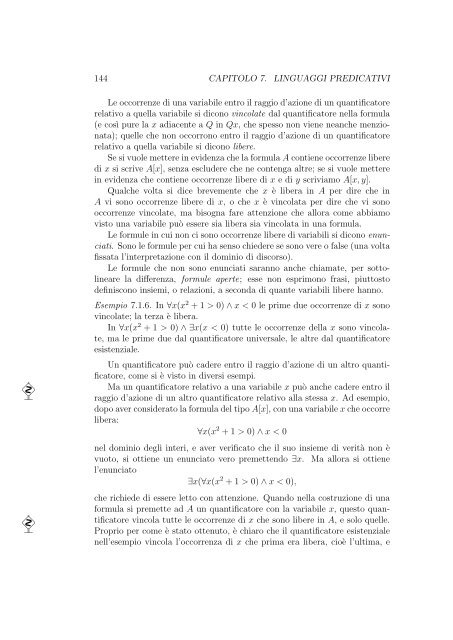Logica Matematica Corso di Laurea in Informatica ... - Mbox.dmi.unict.it
Logica Matematica Corso di Laurea in Informatica ... - Mbox.dmi.unict.it
Logica Matematica Corso di Laurea in Informatica ... - Mbox.dmi.unict.it
You also want an ePaper? Increase the reach of your titles
YUMPU automatically turns print PDFs into web optimized ePapers that Google loves.
144 CAPITOLO 7. LINGUAGGI PREDICATIVI<br />
Le occorrenze <strong>di</strong> una variabile entro il raggio d’azione <strong>di</strong> un quantificatore<br />
relativo a quella variabile si <strong>di</strong>cono v<strong>in</strong>colate dal quantificatore nella formula<br />
(e così pure la x a<strong>di</strong>acente a Q <strong>in</strong> Qx, che spesso non viene neanche menzionata);<br />
quelle che non occorrono entro il raggio d’azione <strong>di</strong> un quantificatore<br />
relativo a quella variabile si <strong>di</strong>cono libere.<br />
Se si vuole mettere <strong>in</strong> evidenza che la formula A contiene occorrenze libere<br />
<strong>di</strong> x si scrive A[x], senza escludere che ne contenga altre; se si vuole mettere<br />
<strong>in</strong> evidenza che contiene occorrenze libere <strong>di</strong> x e <strong>di</strong> y scriviamo A[x, y].<br />
Qualche volta si <strong>di</strong>ce brevemente che x è libera <strong>in</strong> A per <strong>di</strong>re che <strong>in</strong><br />
A vi sono occorrenze libere <strong>di</strong> x, o che x è v<strong>in</strong>colata per <strong>di</strong>re che vi sono<br />
occorrenze v<strong>in</strong>colate, ma bisogna fare attenzione che allora come abbiamo<br />
visto una variabile può essere sia libera sia v<strong>in</strong>colata <strong>in</strong> una formula.<br />
Le formule <strong>in</strong> cui non ci sono occorrenze libere <strong>di</strong> variabili si <strong>di</strong>cono enunciati.<br />
Sono le formule per cui ha senso chiedere se sono vere o false (una volta<br />
fissata l’<strong>in</strong>terpretazione con il dom<strong>in</strong>io <strong>di</strong> <strong>di</strong>scorso).<br />
Le formule che non sono enunciati saranno anche chiamate, per sottol<strong>in</strong>eare<br />
la <strong>di</strong>fferenza, formule aperte; esse non esprimono frasi, piuttosto<br />
def<strong>in</strong>iscono <strong>in</strong>siemi, o relazioni, a seconda <strong>di</strong> quante variabili libere hanno.<br />
Esempio 7.1.6. In ∀x(x 2 + 1 > 0) ∧ x < 0 le prime due occorrenze <strong>di</strong> x sono<br />
v<strong>in</strong>colate; la terza è libera.<br />
In ∀x(x 2 + 1 > 0) ∧ ∃x(x < 0) tutte le occorrenze della x sono v<strong>in</strong>colate,<br />
ma le prime due dal quantificatore universale, le altre dal quantificatore<br />
esistenziale.<br />
Un quantificatore può cadere entro il raggio d’azione <strong>di</strong> un altro quantificatore,<br />
come si è visto <strong>in</strong> <strong>di</strong>versi esempi.<br />
Ma un quantificatore relativo a una variabile x può anche cadere entro il<br />
raggio d’azione <strong>di</strong> un altro quantificatore relativo alla stessa x. Ad esempio,<br />
dopo aver considerato la formula del tipo A[x], con una variabile x che occorre<br />
libera:<br />
∀x(x 2 + 1 > 0) ∧ x < 0<br />
nel dom<strong>in</strong>io degli <strong>in</strong>teri, e aver verificato che il suo <strong>in</strong>sieme <strong>di</strong> ver<strong>it</strong>à non è<br />
vuoto, si ottiene un enunciato vero premettendo ∃x. Ma allora si ottiene<br />
l’enunciato<br />
∃x(∀x(x 2 + 1 > 0) ∧ x < 0),<br />
che richiede <strong>di</strong> essere letto con attenzione. Quando nella costruzione <strong>di</strong> una<br />
formula si premette ad A un quantificatore con la variabile x, questo quan-<br />
tificatore v<strong>in</strong>cola tutte le occorrenze <strong>di</strong> x che sono libere <strong>in</strong> A, e solo quelle.<br />
Proprio per come è stato ottenuto, è chiaro che il quantificatore esistenziale<br />
nell’esempio v<strong>in</strong>cola l’occorrenza <strong>di</strong> x che prima era libera, cioè l’ultima, e




![Introduzione ai sistemi Wiki [PDF] - Mbox.dmi.unict.it](https://img.yumpu.com/16413205/1/184x260/introduzione-ai-sistemi-wiki-pdf-mboxdmiunictit.jpg?quality=85)











